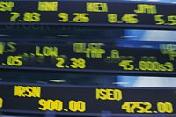
 |
|
| Financial Terms | |
| Soft dollars |
|
Information about financial, finance, business, accounting, payroll, inventory, investment, money, inventory control, stock trading, financial advisor, tax advisor, credit.
Main Page: inventory, stock trading, inventory control, financial advisor, financial, accounting, payroll, finance, |
Definition of Soft dollars
Soft dollarsThe value of research services that brokerage houses supply to investment managers "free of
Related Terms:"Soft" Capital RationingCapital rationing that under certain circumstances can be violated or even viewed Soft currencyA currency that is expected to drop in value relative to other currencies. eurodollarsdollars held on deposit in a bank outside the United States. Constant dollarsSee real dollars. Current DollarsA variable like GDP is measured in current dollars if each year's value is measured in prices prevailing during that year. In contrast, when measured in real or constant dollars, each year's value is measured in a base year's prices. EurodollarsDeposits denominated in U.S. dollars but held in banks located outside the United States, such as in Canada or France. Asian currency units (ACUs)Dollar deposits held in Singapore or other Asian centers.  Average cost of capitalA firm's required payout to the bondholders and to the stockholders expressed as a Blocked currencyA currency that is not freely convertible to other currencies due to exchange controls. CapitalMoney invested in a firm. Capital accountNet result of public and private international investment and lending activities. Capital allocationdecision Allocation of invested funds between risk-free assets versus the risky portfolio. Capital asset pricing model (CAPM)An economic theory that describes the relationship between risk and Capital budgetA firm's set of planned capital expenditures. Capital budgetingThe process of choosing the firm's long-term capital assets. Capital expendituresAmount used during a particular period to acquire or improve long-term assets such as  Capital flightThe transfer of capital abroad in response to fears of political risk. Capital gainWhen a stock is sold for a profit, it's the difference between the net sales price of securities and Capital gains yieldThe price change portion of a stock's return. Capital leaseA lease obligation that has to be capitalized on the balance sheet. Capital lossThe difference between the net cost of a security and the net sale price, if that security is sold at a loss. Capital marketThe market for trading long-term debt instruments (those that mature in more than one year). Capital market efficiencyReflects the relative amount of wealth wasted in making transactions. An efficient Capital market imperfections viewThe view that issuing debt is generally valuable but that the firm's Capital market line (CML)The line defined by every combination of the risk-free asset and the market portfolio. Capital rationingPlacing one or more limits on the amount of new investment undertaken by a firm, either Capital structureThe makeup of the liabilities and stockholders' equity side of the balance sheet, especially  Capital surplusAmounts of directly contributed equity capital in excess of the par value. CapitalizationThe debt and/or equity mix that fund a firm's assets. Capitalization methodA method of constructing a replicating portfolio in which the manager purchases a Capitalization ratiosAlso called financial leverage ratios, these ratios compare debt to total capitalization Capitalization tableA table showing the capitalization of a firm, which typically includes the amount of CapitalizedRecorded in asset accounts and then depreciated or amortized, as is appropriate for expenditures Capitalized interestInterest that is not immediately expensed, but rather is considered as an asset and is then Complete capital marketA market in which there is a distinct marketable security for each and every Cost of capitalThe required return for a capital budgeting project. Cost of limited partner capitalThe discount rate that equates the after-tax inflows with outflows for capital CurrencyMoney. Currency arbitrageTaking advantage of divergences in exchange rates in different money markets by Currency basketThe value of a portfolio of specific amounts of individual currencies, used as the basis for Currency futureA financial future contract for the delivery of a specified foreign currency. Currency optionAn option to buy or sell a foreign currency. Currency riskRelated: Exchange rate risk Currency risk sharingAn agreement by the parties to a transaction to share the currency risk associated with Currency selectionAsset allocation in which the investor chooses among investments denominated in Currency swapAn agreement to swap a series of specified payment obligations denominated in one currency Dedicated capitalTotal par value (number of shares issued, multiplied by the par value of each share). Also Devaluation A decrease in the spot price of the currency
Dual-currency issuesEurobonds that pay coupon interest in one currency but pay the principal in a different Efficient capital marketA market in which new information is very quickly reflected accurately in share Eurocurrency depositA short-term fixed rate time deposit denominated in a currency other than the local Eurocurrency marketThe money market for borrowing and lending currencies that are held in the form of European Currency Unit (ECU)An index of foreign exchange consisting of about 10 European currencies, Foreign currencyForeign money. Foreign currency optionAn option that conveys the right to buy or sell a specified amount of foreign Foreign currency translationThe process of restating foreign currency accounts of subsidiaries into the Hard capital rationingcapital rationing that under no circumstances can be violated. Hard currencyA freely convertible currency that is not expected to depreciate in value in the foreseeable future. Human capitalThe unique capabilities and expertise of individuals. Issued share capitalTotal amount of shares that are in issue. Related: outstanding shares. Legal capitalValue at which a company's shares are recorded in its books. Long-term debt/capitalizationIndicator of financial leverage. Shows long-term debt as a proportion of the Market capitalizationThe total dollar value of all outstanding shares. Computed as shares times current Market capitalization rateExpected return on a security. The market-consensus estimate of the appropriate Multicurrency clauseSuch a clause on a Euro loan permits the borrower to switch from one currency to Multicurrency loansGive the borrower the possibility of drawing a loan in different currencies. Net working capitalCurrent assets minus current liabilities. Often simply referred to as working capital. Nondiversifiability of human capitalThe difficulty of diversifying one's human capital (the unique Opportunity cost of capitalExpected return that is foregone by investing in a project rather than in Other capitalIn the balance of payments, other capital is a residual category that groups all the capital Outstanding share capitalIssued share capital less the par value of shares that are held in the company's treasury. Pecking-order view (of capital structure)The argument that external financing transaction costs, especially Perfect capital marketA market in which there are never any arbitrage opportunities. Perfect market view (of capital structure)Analysis of a firm's capital structure decision, which shows the Personal tax view (of capital structure)The argument that the difference in personal tax rates between Pie model of capital structureA model of the debt/equity ratio of the firms, graphically depicted in slices of Planned capital expenditure programcapital expenditure program as outlined in the corporate financial plan. Pro forma capital structure analysisA method of analyzing the impact of alternative capital structure Real capitalWealth that can be represented in financial terms, such as savings account balances, financial Reporting currencyThe currency in which the parent firm prepares its own financial statements; that is, U.S. Reserve currencyA foreign currency held by a central bank or monetary authority for the purposes of Static theory of capital structureTheory that the firm's capital structure is determined by a trade-off of the Venture capitalAn investment in a start-up business that is perceived to have excellent growth prospects but Virtual currency optionA new option contract introduced by the PHLX in 1994 that is settled in US$ rather Weighted average cost of capitalExpected return on a portfolio of all the firm's securities. Used as a hurdle Working capitalDefined as the difference in current assets and current liabilities (excluding short-term Working capital managementThe management of current assets and current liabilities to maximize shortterm liquidity. Working capital ratioWorking capital expressed as a percentage of sales. CAPITALThe money, raised by selling stock or bonds or taking out loans, that you use to start, operate, and grow a business. CAPITAL IN EXCESS OF PAR VALUEWhat a company collected when it sold stock for more than the par value per share. CapitalThe shareholders’ investment in the business; the difference between the assets and liabilities Capital employedThe total of debt and equity, i.e. the total funds in the business. CapitalizeTo make a payment that might otherwise be an expense (in the Profit and Loss account) an asset Capital marketThe market in which investors buy and sell shares of companies, normally associated with a Stock Exchange. Cost of capitalThe costs incurred by an organization to fund all its investments, comprising the risk-adjusted Return on capital employed (ROCE)The operating profit before interest and tax as a percentage of the total shareholders’ funds plus Weighted average cost of capitalSee cost of capital. Working capitalCurrent assets less current liabilities. Money that revolves in the business as part of the process of buying, making and selling goods and services, particularly in relation to debtors, creditors, inventory and bank. Additional paid-in capitalAmounts in excess of the par value or stated value that have been paid by the public to acquire stock in the company; synonymous with capital in excess of par. Capital in excess parAmounts in excess of the par value or stated value that have been paid by the public to acquire stock in the company; synonymous with additional paid-in capital. Contributed capitalThe amount put into the business by the owners by purchasing stock and by paying more than the par value for the stock (additional paid-in capital or capital in excess of par). capitalA very broad term rooted in economic theory and referring to capital budgetingRefers generally to analysis procedures for ranking capital expendituresRefers to investments by a business in long-term Related to : financial, finance, business, accounting, payroll, inventory, investment, money, inventory control, stock trading, financial advisor, tax advisor, credit. |